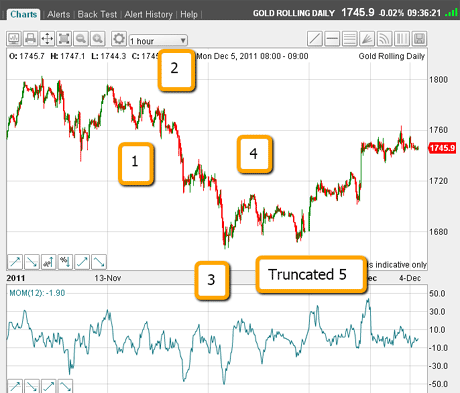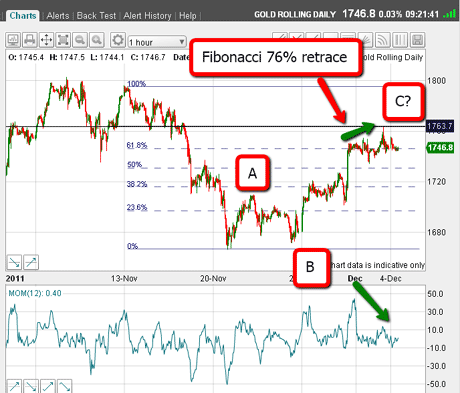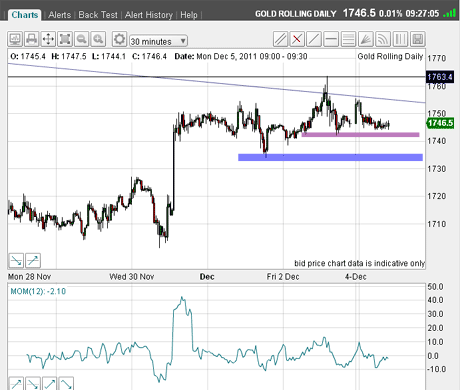Gold rallies to important resistance levels
Gold's rally has hit some resistance, and the odds are stacking up that the we have seen a top for now, says John C Burford. Here, he looks at how to play the next phase of the gold market.
In my last article on gold, I had pencilled in my Elliott wave count on the decline from the 13 November high at a little under $1,800 an ounce, to the recent $1,670 low.
I labelled that low as my wave 3. A wave 4 rally then followed. I was looking for a drop from there into wave 5.
The market did decline off that wave 4, but failed to make a low under $1,670.
MoneyWeek
Subscribe to MoneyWeek today and get your first six magazine issues absolutely FREE

Sign up to Money Morning
Don't miss the latest investment and personal finances news, market analysis, plus money-saving tips with our free twice-daily newsletter
Don't miss the latest investment and personal finances news, market analysis, plus money-saving tips with our free twice-daily newsletter
Below is the chart showing the truncated fifth.
When the market moved up off that wave 5 low and took out the wave 4 high that was the clue that all was not right with my first analysis.
I had expected a consistent decline going into the latter half of November. But it was not to be.
My short sale was protected by my break-even stop - I had moved my protective stop down to break-even while the market was making wave 5.

(Click on the chart for a larger image)
Trader tip: My break-even rule has kept me out of many potentially losing trades I recommend its use for all traders. The number one rule for traders is to protect your capital as much as possible, but to give your trades enough room to produce the big winners.
So where to now for gold?
Since the gold market has been strongly correlated with the US dollar - and stocks - when the euro and stocks rallied off their 27 November lows, gold followed suit.
So now, let's look at the daily chart:

(Click on the chart for a larger image)
Last week's rally to the $1,760 level (marked by the yellow arrow) took the market to the major downtrend line. Moving above this line would require a major push.
Gazing at the current hourly chart now:

(Click on the chart for a larger image)
I can note several important points from the chart:
At last week's $1,760 high (marked by the top green arrow), the market had retraced an exact Fibonacci 76% of the decline off the $1,800 high - this is a typical reversal point.
There is a clear A-B-C - corrective - pattern to the $1,760 high.
There is a clear negative momentum divergence between the A wave and the C wave (marked by the bottom green arrow) - this is normally a sign that the C wave is weak and the market is ready to reverse.
The $1,760 high lies right on the major downtrend line, as shown in the first chart above.
So, the odds are stacking up that the $1,760 high is very likely a major top (at least, for now).
How to play this? A short sale could have been made near that $1,760 high with the knowledge provided by my list above.
Failing that, I will bring in my standard entry method - to short on a break of minor support. Here is the 30-minute chart:

(Click on the chart for a larger image)
I have minor support at the levels shown by the pink and blue bars. These supports are at levels that have recently acted as supports. So any break of them would normally be significant, and is where sell stop-loss orders are concentrated.
Because of the on-going eurozone developments this week, we could well see a pick-up in volatility, and even a surge to new highs if stocks get wind of a better crisis management outcome.
That is why I am trading lightly at present in these skittish - and highly political - markets.
But that could all change in an instant! As traders, we must be alert to the signals the markets are sending us, and they could come at any moment.
If you're a new reader, or need a reminder about some of the methods I refer to in my trades, then do have a look at my introductory videos:
Advanced trading with Elliott waves
An introduction to Elliott wave theory
The essentials of tramline trading
Don't miss my next trading insight. To receive all my spread betting blog posts by email, as soon as I've written them, just sign up here .
Get the latest financial news, insights and expert analysis from our award-winning MoneyWeek team, to help you understand what really matters when it comes to your finances.
John is is a British-born lapsed PhD physicist, who previously worked for Nasa on the Mars exploration team. He is a former commodity trading advisor with the US Commodities Futures Trading Commission, and worked in a boutique futures house in California in the 1980s.
He was a partner in one of the first futures newsletter advisory services, based in Washington DC, specialising in pork bellies and currencies. John is primarily a chart-reading trader, having cut his trading teeth in the days before PCs.
As well as his work in the financial world, he has launched, run and sold several 'real' businesses producing 'real' products.
-
 Why UK investors are backing British stocks in 2026
Why UK investors are backing British stocks in 2026The UK stock market may be lacking fashionable technology shares but investors are keen to buy British next year
-
 UK inflation live: Inflation fell to 3.2% in November
UK inflation live: Inflation fell to 3.2% in NovemberA rise of 3.2% in CPI inflation in the 12 months to November undershoots almost all expectations